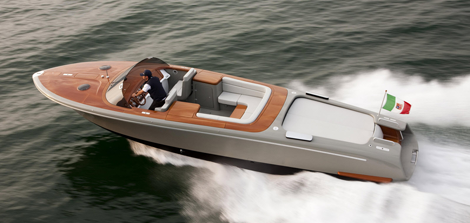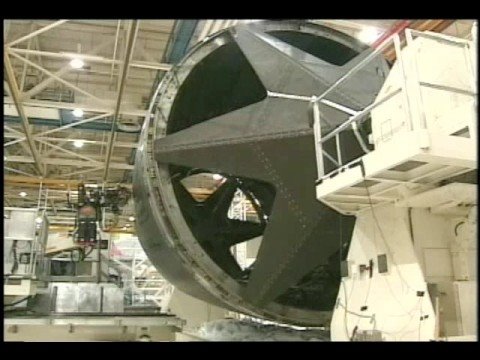
Some of the amazing works of Marc Newson Ltd will be presented by the studio’s design director later today
Today we’ll be bringing you live news and exciting happenings from Rhino’s UK user meeting – more of a mini conference held in the cosy crypt of a Clerkenwell church – with an amazing line up of speakers.
As well as interesting users stories, expect some sneak previews of the next release of Rhino, which should include a long awaited version for Mac.
Follow the day as it goes along below the line, and feel free to tweet us any questions as we go.
9.45 – Bit of history about the venue – the crypt is over 800 years old but still has good wifi – have a think about that Hackney Council…
9.55 – Carlos Pérez from McNeel Europe is opening up the morning with a bit of company info – they’re 90 people worldwide, which still astounds us given the popularity of the software globally, 350,000 registered users.
Today Carlos is here to talk about Rhino for Mac – the development started in 2007, and it has had 350,000 beta testers in that time – with the first commercial release available very soon!
10.00 – In other Apple news – the latest Mac Pro was tested using a Rhino model of a Ferrari.
Rhino for Mac will not be the same as Rhino for Windows – plugin support is not quite there yet, and there’s a question mark over the Rhino Script properties, and there’s no Grasshopper or VRay yet – although the point releases will be made free to buyers of the launch version.

The full list of differences can be found here.
10.10 – Grasshopper 2 development has started, and although it’ll still take a year to appear, Rhino is aiming to make it cross platform from the launch.
A commercial license of Rhino for Mac will cost €295 at launch. If you beta tested Rhino for Mac and own Rhino for Windows, there’s an even cheaper offer of €95.
10.15 – Rhino Work In Progress (WIP) – ‘some of this will be in Rhino 6 and some will not…’ – Carlos likes to keep you guessing.
– Rhino is looking at making Grasshopper included in the package.
– Better mesh tools
– SubD is making progress, but is still taking ages – it will be a completely new model type in Rhino, but supported by all existing tools, with a familiar UI.
– Modelling will come with History
– Increases in display performance, rendering and visualisation
– Further support for SolidWorks 2015
– RhinoCycles will be a GPU-accelerated renderer
10.20 – A quick (read: brave) live demo of the SubD feature looks a bit unpolished, although, as Carlos is keen to point out, many features are still missing and things are very much still in development.
10.25 – Food4Rhino new website with over 250 new plug-ins for Rhino available to download, with a large number for free.

The Hazza Bin Zayed Stadium in the UAE, designed by Pattern Design architects
10.30 – Pattern Design are next on stage with its work on the Hazza Bin Zayed Stadium – Patterns and mathematics are the key research areas for this 30-man design practise, hence they luuuuuurve Grasshopper.
The team behind the bowl design are self-confessed ‘stadium geeks’ – and this must have taken some effort for them (the football club owners wanted to build a 35,000 seat monster, despite attendance only having 5,000 people turning up to home games) trying to put across logical design.
10.45 – Interesting ways in which they tried to retain the atmosphere of such a limited crowd through good design – open concourses behind the seating, pushing seating as close to the pitch as possible etc. The project also had a lot of environmental considerations (it’s baking hot in those parts) so the facade panels were cleverly designed to open (like flaps) to allow the cool air to flow in at game times. This required a ton of optimisation and some 1:1 scale prototyping.
A nice bonus of this panelling on different angles means for some interesting architectural lighting.
Thanks mainly to the redesign, the team has tripled its game day attendances since opening – primarily as its a better atmosphere to watch the games.

The first Shoes By Bryan collection
11.00 – Bryan Oknyansky is up next with his company Shoes By Bryan – trained as an architect, he’s morphed through using Rhino to move from one discipline to work in another.
His first collection of high heels was his first attempt at footwear – a lot of which were designed to be 3D printed. He found that design tools for footwear were quite traditional, and that once you’d got past the basic stages it’s pretty much the same as designing a building.
From using metals Bryan moved into working with wood, designing for CNC machining, and now has a deal with 3D Systems, which helps him prototype and even manufacture shoes.
11.25 – Now we have Robots IO, which is aiming to make the programming of 7-axis robots much easier. It’s from the same brainy people behind Robofold.
https://player.vimeo.com/video/124919038?color=ffffff&title=0&byline=0&portrait=0
The project is currently working with Cranfield University for generating toolpaths for 3D printing metals, producing a pre-process visualisation before the real robots get cracking on the welding.
Another application for this is robotic CNC milling – making it easy enough for users that have never had to use Grasshopper before. There’s a 90-day free trial on its website so you can give it a whirl.
12.00 – Coffee break over and Dr William Tiu, lead mechanical analysis engineer at BAE Systems, is bringing us into the secret squirrel world of analysis and how Rhino fits with Pro/E, Ansys CFD, Spaceclaim, and a whole host of other applications. Dr Tiu mentions that he helps design helmets for military personnel ejecting from aircraft – already this sounds cool!
When reverse engineering products, the team use high speed video to capture drop tests into water, and use Rhino to record the distances. Sadly that’s about all we can glean about the work going on at BAE, and instead we’re looking at some side projects that involve 3D printing and using various Rhino plugins.
12.20 – Next we’re going to take a look at Rhino plug-in Kangaroo that runs through Grasshopper, which adds in realtime physics simulation to CAD tools to see how objects behave in different ways.
The new version has new uses for part measurements, where set parameters can be laid down and realtime changes are reflected in movements – best explained by the video below:
Some interesting work going on for adding in clash-detection aspects, allowing CAD models – in this case a digger – to be moved like a real digger would move, to test for angles and possible collision points during the early design stages.
One of the best things we’ve seen is this being used along with new hardware, such as VR glasses and Leap Motion controllers, which allows for virtual origami.
12.30 – Nicolas Register, design director at Marc Newson Ltd brings the event up to lunch with how the design studio works with Rhino – usually from early in the process: ‘the best place to explore ideas quickly’.

The Random Pak Chair by Marc Newson
The Random Pak chair was created before the studio were aware of Grasshopper (having to use some architectural tool), and used a 3D printed inner supported (1,600 hours worth back in 2007) before metal electro forming to build it.
The design team have worked on everything from seating to planes – such as the Kelvin40 Concept plane – “all of this stuff is form and shape where Rhino fits in”.

Aquariva speedboat, had to work with existing constraints – the hull and the engine couldn’t be changed for the seafaring engineering – which were ‘completely analogue’ in their design documents, requiring a 3D scan, with not even 2D plans.
Rhino was used in depth for the top half, where most of it would be formed from a single fibreglass part. Needed to ensure all the component parts that would be added on to the main form would fit on to this model.
The details on the craft are amazingly well crafted, with lots of smooth, flowing edges – ‘plushness’ is the most used term by Nicholas.
Marc Newson seems obsessed with reducing the amount of bits and pieces, as the concept for the 486 Beretta shotgun shows. Reducing the amount of parts in the make up of the gun’s receiver, and making it a plush single part, that was then unwrapped in CAD into a 2D part so it could be laser engraved.

The 486 Beretta
The process took a lot of niggling mesh tweaking, nearly a week’s worth, to get it as a single form with minimal distortion, and the key joint between the two barrels to marry up perfectly. From there the artwork could be worked on – in this case a dragon – and laid over and mapped on the 3D form.

One of Michael Eden’s digitally inspired and created objects
2.15 – The jangling of crockery in the background means that the lunch break is over as we head back for more Rhino action – beginning with Michael Eden, a man that creates ceramic objects d’art using Rhino through 3D printing.
‘Rhino was a really simple extension of a sketchbook… I soon found it was very useful for creating different iterations of an object.’
Eden used a mix of traditional pottery methods, and digital iterations to get to a shape that he was happy with, before having a master CNC milled and then used as an industrial mould.
From here he turned to designs from the original Industrial Revolution from the 1870s and redesigned them with a twist of digital bone structure.
2.45 – It’s time for some VRay updates with Chaos Group 3D Artist Mikel Jagan. Version 3.0 for Rhino is in development and here we’re getting some quick (ie. too fast for me to keep up by typing) peaks at the updates to the render workflow that are bringing VRay for Rhino’s features more in line with those in 3ds Max and Modo.
3.00 – If you’re interested in VRay for Grasshopper, then this is happening elsewhere in the world:
.@coreyrubadue announces #vray for #gh3d, vrscans (shaders from #realityCapture) & vraycloud at @ChaosGroup VRAY Days pic.twitter.com/BM8VoA0Tcy
— Brian Ringley (@brianringley) June 9, 2015






